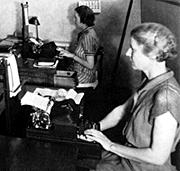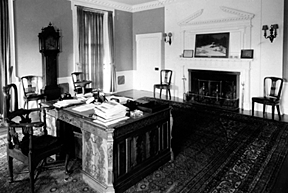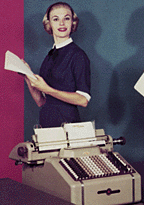
The Postwar Economy and the Office
When World War II ended, management and the office environment
changed radically and quickly. Workers on the homefront, including many
women who were filling in for the men at war, had essentially maintained
the status quo during this period of national upheaval. But with the  war over, American industry tooled up to satisfy pent-up demand
for consumer goods after the long war years of scarcity. Factory jobs were
paying far more for unskilled and semi- skilled labor than were office jobs.
war over, American industry tooled up to satisfy pent-up demand
for consumer goods after the long war years of scarcity. Factory jobs were
paying far more for unskilled and semi- skilled labor than were office jobs.
Employers had to make office work more attractive. Instead of increasing clerical salaries, however, management emphasized the respectability or status of office work. Scientific management was modified to make jobs less routine, and the look of the office began to change to outwardly show this functional change.
Advertisements for jobs described "friendly" offices and bosses. Attractive health insurance and retirement plans became part of the financial rewards for working.
Physically, offices were being "landscaped." No longer cousins to the factory production line, offices became color-coordinated with comfortable and attractive furniture. While executive and upper management offices had always conveyed the good taste of their inhabitants, general offices now gave out the same message: a clerk who worked in pleasant surroundings was obviously someone enlightened if not culturally superior. For many workers, their office environment was far more luxurious than their homes.

The role of status in American culture is a complex topic better treated elsewhere. Within this context it should be recognized, however, that in the booming postwar years Americans were able to fulfill long-held dreams of home ownership, higher education for their children, and the acquisition of objects and symbols of wealth. Factory work with its lower-class or working-class connotations thus became less attractive to many people than the clean, gracious environment of a corporate office.
In the postwar era of change, scientific management was
replaced with human relations. Management had discovered from experience
that people restricted to their desks doing repetitious tasks became fatigued
before the end of the day. By giving workers breaks in their day, more varied
work to perform, and coworkers to work with rather than alongside of, they
actually became more,  not less, productive. People generally no longer just typed or
filed all day. If they did, such activity at least took place in a friendly
office with plants. The humanitarian style of management worked, and company
loyalty and productivity increased.
not less, productive. People generally no longer just typed or
filed all day. If they did, such activity at least took place in a friendly
office with plants. The humanitarian style of management worked, and company
loyalty and productivity increased.
By the 1960s, most offices were carpeted and relatively well furnished. Some workplaces piped in music; most were softly but effectively lit. Equipment was "the latest," and workers began to see their work as important to the company.